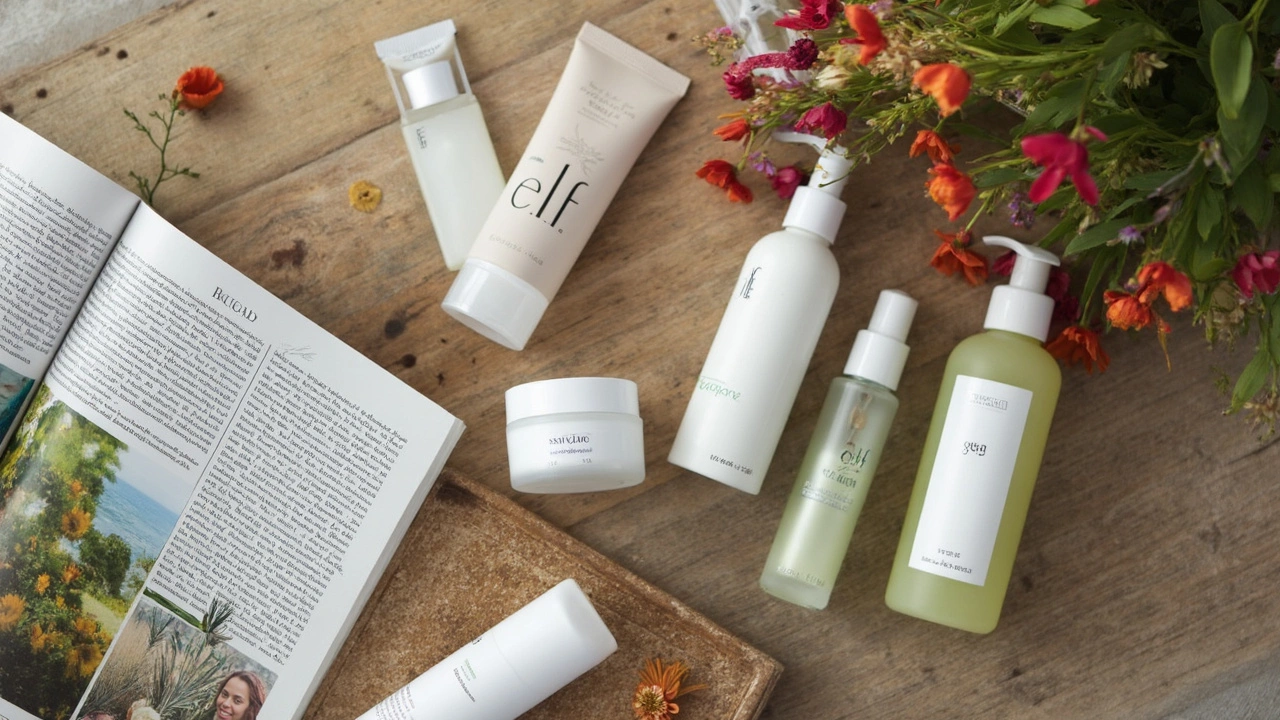The skincare aisle is packed with all sorts of brands claiming to be green, clean, or good for your skin. Elf is everywhere these days, shouting about being cruelty-free and vegan. But does that mean it's actually organic? Not exactly. And that's something a lot of people miss when scanning those cute pastel bottles.
Let's get straight to it. There are plenty of little logos and buzzwords floating around in beauty marketing, and 'organic' is one of the trickiest. Just because a moisturizer says it’s “natural” or “clean” doesn’t mean it’s truly organic. And with Elf, things get a little murky once you flip over the box and read the ingredients.
If you want to avoid synthetic chemicals and mostly stick to plant-based ingredients, you can’t just trust the front label. Lots of brands (including Elf) toss around healthy-sounding claims, but it pays to know what actually counts as organic in the world of skincare. That honesty will save you a wallet full of impulse buys—and maybe some breakouts too.
- What Does 'Organic' Mean in Skincare?
- Elf’s Brand Philosophy: More Affordable Than Organic?
- A Close Look at Elf’s Ingredients
- Cruelty-Free, Vegan, and Clean—But Not Organic?
- How Elf Compares to Certified Organic Brands
- Tips for Shopping for Truly Organic Skincare
What Does 'Organic' Mean in Skincare?
Here's the thing—"organic" isn't just a word brands can slap on a label and hope for the best. In skincare, "organic" has rules. If you see a product labeled as certified organic in the U.S., it should follow USDA standards. Those rules say at least 95% of the ingredients must be grown without synthetic pesticides, GMOs, or harsh fertilizers. That’s stricter than "natural," which anyone can say about just pretty much anything.
Not sure how to spot real organic? Look for stamps or seals from groups like the USDA or COSMOS. Otherwise, you're just trusting marketing. According to Ecocert, a major organic certifier in the EU,
"Organic certification means a brand has committed to transparency from farm to face—it's about how ingredients are grown, harvested, and handled."
It’s easy to get confused by all the badges out there. Just because something is vegan or cruelty-free doesn’t mean it’s organic skincare. Here’s a snapshot that helps break it down:
| Label | Main Focus | What it Means |
|---|---|---|
| Organic | Ingredients and Farming | Strict farming methods, 95% organic content min. |
| Vegan | No Animal Products | No animal ingredients but can use synthetics. |
| Cruelty-Free | No Animal Testing | Never tested on animals but doesn't mean organic. |
| Natural | Derived from Nature | Mostly from plants or minerals; no strict rules. |
One more thing—organic skincare products usually come with a bigger price tag, because organic farming just costs more. But you’re getting creams and serums with fewer harsh extras, which sounds pretty nice if your skin throws a fit at the slightest irritation.
If you’re serious about ditching synthetic chemicals and want the real deal, always check for a legitimate organic certification badge. Everything else? That’s just smart marketing.
Elf’s Brand Philosophy: More Affordable Than Organic?
Elf, or Eyes Lips Face, isn’t out here promising to be the purest brand or the most expensive option on the shelf. Instead, their main pitch is all about smart pricing and broad accessibility. The company says it wants to "make luxurious beauty accessible to every eye, lip, and face." So, if you’ve ever wondered why their creams cost less than half the price of fancy organic products, it’s intentional.
Elf is very clear: they don’t claim to be 100% organic. What they focus on is giving you good-looking makeup and skincare that’s Elf—meaning cruelty-free, vegan, and affordable. While organic formulas are often pricier because they skip synthetic stuff and stick to certified sources, Elf prioritizes value. That’s why you’ll see their products in drugstores and supermarkets, not health food shops.
To give an idea of where Elf stands compared to organic brands, check this out:
| Brand | Average Moisturizer Price (USD) | Certified Organic? | Vegan? | Main Retailers |
|---|---|---|---|---|
| Elf | $13 | No | Yes | Target, Walmart, Ulta |
| Dr. Bronner's | $21 | Yes | Yes | Whole Foods, Sprouts |
| Juice Beauty | $40 | Yes | Yes | Ulta, Juice Beauty |
Elf’s ability to keep prices down partly comes from their choice of ingredients. They often use safe synthetic alternatives, common preservatives, and non-organic plant extracts. If you’re hoping for USDA Organic stamps or ECOCERT logos, you won’t see them on Elf packaging. That’s one way they sidestep higher costs while still making vegan options and avoiding animal testing.
This all means Elf is for folks who want decent skincare on a regular paycheck—not for purists who insist on strictly certified organic everything. If your main concern is affordability with a side of ethical values (like being cruelty-free), you’ll probably find Elf fits.
A Close Look at Elf’s Ingredients
If you take a second to actually read Elf product labels, you’ll spot a big mix of ingredients. So, is Elf organic? Not really, and here’s why—it doesn’t use certified organic ingredients as the standard. Instead, most Elf skincare lines rely on safe synthetics and select plant-based extras mixed in. They’re proudly vegan, which means no animal stuff, but vegan doesn’t mean organic. That’s a huge detail people tend to mix up.
For example, the Holy Hydration Face Cream from Elf has shea butter, hyaluronic acid, and niacinamide. That sounds skin-friendly, but if you check the full list, you’ll also see phenoxyethanol (a chemical preservative), ethylhexylglycerin, and other lab-made stuff. Elf products usually skip out on things like parabens and sulfates, which is great, but they’re not going 100% natural or organic.
Here’s a basic breakdown of what you’ll usually find in Elf’s most popular skincare:
- Plant oils (like jojoba or shea butter)
- Synthetic emollients (moisturizing agents)
- Lab-created preservatives (to stop bacteria growth)
- Safe chemical stabilizers (keep products fresh longer)
If you’re the kind of person who counts every synthetic, these extras can be a deal-breaker. But if you just want affordable skincare, Elf pulls off a middle ground—more “clean” than truly “organic.”
Here’s a peek at some of the common Elf skincare ingredients, and what they do:
| Ingredient | What It Does |
|---|---|
| Niacinamide | Helps with pores and redness |
| Hyaluronic Acid | Adds a shot of moisture |
| Phenoxyethanol | Keeps products free from bacteria |
| Glycerin | Hydrates |
| Shea Butter | Conditions skin with a natural oil |
| Ethylhexylglycerin | Preservative booster |
| Cetearyl Alcohol | Makes creams smooth (not the drying kind of alcohol) |
The gist? If you want products loaded with certified organic, farm-sourced ingredients, Elf isn’t your brand. But if you’re looking for decent vegan options with fewer harsh chemicals, their ingredients list is pretty transparent, especially for the price.

Cruelty-Free, Vegan, and Clean—But Not Organic?
Elf has built its reputation on being cruelty-free and vegan, which means they don’t test on animals and they skip any animal-derived ingredients. That’s a big win for lots of people who care about animal welfare or want to avoid things like beeswax or collagen. Plus, Elf even has a “clean” line, which usually means leaving out some of the biggest bad guys in skincare, like parabens, sulfates, and phthalates.
But here’s where things get real: cruelty-free and vegan don’t automatically mean organic skincare. You won’t find an official organic certification on any Elf packaging, and if you dig into their FAQ, they’re upfront about it—they don’t call themselves an organic brand. Their products often contain synthetics and lab-made ingredients along with some plant extracts. “Clean” in beauty is a pretty flexible word, and every brand seems to have their own take. So, something can be clean by Elf’s standards but still have chemical preservatives or other ingredients grown with regular farming methods.
It sounds a bit confusing, right? Just remember, there’s no law that says vegan or cruelty-free has to mean organic. For Elf, it’s more about making affordable products without animal byproducts or animal testing. They list their ingredients clearly, which is helpful if you want to check for certain things. But if you’re after skincare that’s 100% made from organic farming with zero synthetics, you’ll need to look elsewhere.
- If you want strictly organic, check for third-party logos like USDA Organic or COSMOS on packaging.
- Don’t get sidetracked by the word “clean”—always read the ingredient list.
- Just because it’s cruelty-free doesn’t mean it’s made with organic ingredients.
How Elf Compares to Certified Organic Brands
Let’s lay it out plain and simple: Elf isn’t certified organic. If you’re holding a bottle of their moisturizer wondering if it stacks up to brands like Dr. Bronner’s or Juice Beauty, the answer’s pretty clear. Here’s why.
Certified organic skincare brands have to follow strict rules set by third-party groups like USDA Organic or COSMOS. This means at least 95% of their ingredients need to be organic (grown without synthetic fertilizers, pesticides, or GMOs). Plus, certified organic products are forbidden from containing a long list of chemicals and artificial stuff found in regular drugstore products.
| Brand | Certified Organic? | Main Ingredients | Typical Price Range |
|---|---|---|---|
| Elf | No | Water, synthetics, some plant extracts | $6-$16 |
| Juice Beauty | Yes (USDA, COSMOS) | Certified organic juices, plant oils | $20-$70 |
| Dr. Bronner’s | Yes (USDA) | Organic oils, essential oils | $10-$25 |
When you check Elf’s ingredient lists, you’ll find a mix: water, glycerin, some plant extracts, along with lots of lab-created stuff like silicones, synthetic preservatives, and fragrances. There might be a few plant-based bits in there, but they’re usually not organic or labeled as such. Contrast that with certified organic brands, where you can actually see which ingredients are marked as certified organic—usually right on the bottle, not just buried on the website.
Price is another big difference. Elf is much more budget-friendly, and that’s honestly one of their selling points. You won’t find many certified organic products at Elf prices. But you’re trading savings for synthetics. Real organic brands usually cost more because growing and certifying organic ingredients takes a lot more time and money.
Next time you’re shopping, look for third-party certification logos like USDA Organic, COSMOS, or Ecocert if you want truly organic. If you just want cruelty-free and vegan, Elf ticks those boxes, but for full-on organic, you’ll have to look elsewhere.
Tips for Shopping for Truly Organic Skincare
Trying to shop for real organic skincare can feel like a maze. There’s a ton of buzzwords, and not every jar that whispers “natural” is actually what you want. If you’re serious about avoiding fake claims, you need to know what to look for and what to skip. Let’s break it down and make it simple:
The big tip? Don’t trust the front label. Flip the product over and check for real certifications, like USDA Organic or COSMOS Organic. These seals mean strict rules were followed—at least 95% of the ingredients must be organic for USDA-certified stuff.
“Terms like ‘natural’ and ‘organic’ aren't regulated in the same way in cosmetics as they are with food. Look for recognized organic certifications to know you're getting the real thing.” — Environmental Working Group (EWG)
Here’s a quick cheat sheet for reading those tricky labels:
- USDA Organic: This gold-standard seal means 95% or more of the product is organic.
- COSMOS Organic: European certification that's strict with ingredients and how they're sourced.
- NSF/ANSI 305: Shows products with at least 70% organic ingredients.
- No seal? Be extra cautious. It probably isn’t truly organic.
Don’t stop at the logos. Always check the ingredient list. The first few ingredients make up most of the product. If water, plant oils, or botanical extracts show up at the top—and you see a matching organic logo—you're probably in good shape. Watch for sneaky synthetic stuff like parabens, phthalates, or artificial fragrance. If they're there, it’s not fully organic.
Here’s how a true organic skincare buy might stack up compared to non-organic:
| Organic Skincare | Non-Organic Skincare | |
|---|---|---|
| % Organic Ingredients | 95%+ (with USDA seal) | 0-69% |
| Main Ingredients | Plant-based, natural extracts | Synthetic chemicals, artificial dyes |
| Typical Price Range | $15–$40 (mid-range brands) | $8–$25 (mass market, high-end varies) |
| Certifications | USDA, COSMOS, NSF/ANSI 305 | Usually none |
Not every product in the organic skincare aisle is worth your money. Take your time, snap photos of ingredient lists, and double-check online if you’re unsure. And hey, if you find a new favorite, tell your friends so they don’t get tricked by greenwashing, either.


